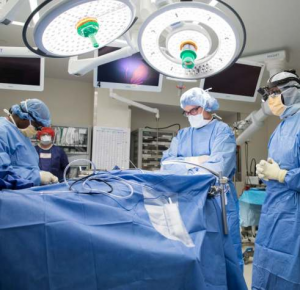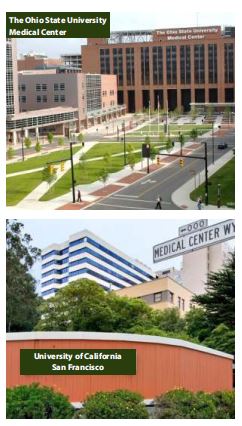The US remains the largest medical device market in the world: $156 billion (40 percent of the global medical device market in 2017).
By 2023, it is expected to grow to $208 billion. US exports of medical devices in key product categories identiϐied by the Department of Commerce exceeded $43 billion in 2018.
The United States of America, commonly known as the US or America, is a country primarily located in North America. It consists of 50 states, a federal district, five major unincorporated territories, 326 Indian reservations, and some minor possessions. At 3.8 million square miles (9.8 million square kilometers), it is the world’s third- or fourth-largest country by total area. With a population of more than 331 million people, it is the third most populous country in the world. The national capital is Washington, DC, and the most populous city is New York City.
 The United States is a federal republic and a representative democracy with three separate branches of government, including a bicameral legislature. It is a founding member of the United Nations, World Bank, International Monetary Fund, Organization of American States, NATO, and other international organizations. It is a permanent member of the United Nations Security Council. Considered a melting pot of cultures and ethnicities, its population has been profoundly shaped by centuries of immigration. The US ranks high in international measures of economic freedom, reduced levels of perceived corruption, quality of life, quality of higher education, and human rights. However, the country has received criticism in regard to inequality related to race, wealth and income, the use of capital punishment, high incarceration rates, and lack of universal health care.
The United States is a federal republic and a representative democracy with three separate branches of government, including a bicameral legislature. It is a founding member of the United Nations, World Bank, International Monetary Fund, Organization of American States, NATO, and other international organizations. It is a permanent member of the United Nations Security Council. Considered a melting pot of cultures and ethnicities, its population has been profoundly shaped by centuries of immigration. The US ranks high in international measures of economic freedom, reduced levels of perceived corruption, quality of life, quality of higher education, and human rights. However, the country has received criticism in regard to inequality related to race, wealth and income, the use of capital punishment, high incarceration rates, and lack of universal health care.
The United States is a highly developed country, and continuously ranks high in measures of socioeconomic performance. It accounts for approximately a quarter of global GDP and is the world’s largest economy by GDP at market exchange rates. By value, the United States is the world’s largest importer and the second-largest exporter of goods. Although its population is only 4.2% of the world total, it holds 29.4% of the total wealth in the world, the largest share held by any country. Making up more than a third of global military spending, it is the foremost military power in the world and is a leading political, cultural, and scientiöc force internationally.
Healthcare in the US
Health care in the US is provided by many distinct organizations, made up of insurance companies, healthcare providers, hospital systems and independent providers. Health care facilities are largely owned and operated by private sector businesses. 58% of community hospitals in the United States are non-proöt, 21% are government-owned, and 21% are for-profit. According to the World Health Organization (WHO), the United States spent $9,403 on health care per capita, and 17.9% on health care as percentage of its GDP in 2014. Healthcare coverage is provided through a combination of private health insurance and public health coverage (e.g., Medicare, Medicaid). The United States does not have a universal healthcare program, unlike most other developed countries.
With global health care spending expected to rise at a CAGR of 5 percent in 2019-23 (deloittle), it will likely present many opportunities for the sector. While there will be uncertainties, stakeholders can navigate them by factoring in historic and current drivers of change when strategizing for 2020 and beyond. Among these drivers are a growing and aging population, rising prevalence of chronic diseases, infra structure investments, technological advancements, evolving care models, higher labor costs amidst workforce shortages, and the expansion of health care systems in developing markets.
Health care systems need to work toward a future in which the collective focus shifts away from treatment, to prevention and early intervention.
 Outlook of medical technology industry in the US The United States remains the largest medical device market in the world: $156 billion (40 percent of the global medical device market in 2017). By 2023, it is expected to grow to $208 billion. US exports of medical devices in key product categories identifified by the Department of Commerce exceeded $43 billion in 2018. The medical technology industry (commonly referred to as medical devices) consists of articles, instruments, apparatuses, or machines that are used in the prevention, diagnosis or treatment of illness or disease, or for detecting, measuring, restoring, correcting, or modifying the structure or function of the body for some health purpose. Typically, the purpose of a medical device is not achieved by pharmacological, immunological, or metabolic means (selectUSA).
Outlook of medical technology industry in the US The United States remains the largest medical device market in the world: $156 billion (40 percent of the global medical device market in 2017). By 2023, it is expected to grow to $208 billion. US exports of medical devices in key product categories identifified by the Department of Commerce exceeded $43 billion in 2018. The medical technology industry (commonly referred to as medical devices) consists of articles, instruments, apparatuses, or machines that are used in the prevention, diagnosis or treatment of illness or disease, or for detecting, measuring, restoring, correcting, or modifying the structure or function of the body for some health purpose. Typically, the purpose of a medical device is not achieved by pharmacological, immunological, or metabolic means (selectUSA).
The industry includes almost 2 million jobs in the United States, including both direct and indirect employment. Medical technology directly accounts for well over 300,000 of these jobs. More than 80 percent of medical device companies in the United States consist of fewer than 50 employees, and many (notably start-up companies) have little or no sales revenue. U.S. medical device companies are highly regarded globally for their innovative and high technology products. R&D spending continues to represent a high percentage of medical device industry expenditures, averaging 7 percent of revenue. Compared to several other industries including automotive, defense, and telecommunications, the medical device industry invests a higher percentage of yearly revenues into product innovation, reflecting the competitive nature of the industry and constant innovation and improvement of existing technologies.
The medical device industry relies on several industries where the United States holds a competitive advantage, including microelectronics, telecommunications, instrumentation, biotechnology, and software development. Collaborations have led to recent advances including neuro-stimulators, stent technologies, biomarkers, robotic assistance, and implantable electronic devices. Since innovation fuels the medical device sector’s ongoing quest for better ways to treat and diagnose medical conditions, when coupled with patient life expectancy increasing and aging populations globally, the medical device sector should continue growing at a positive rate in the future.














